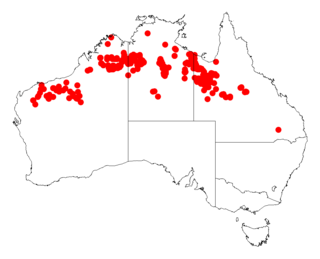
Acacia brachypoda, known colloquially as western wheatbelt wattle or Chinocup wattle, is an endangered species of Acacia restricted to a small locality in western Australia's wheatbelt.
Acacia anastomosa, also known as Carson River wattle, is a shrub belonging to the genus Acacia and the subgenus Juliflorae that is endemic to north western Australia.

Acacia cyclocarpa, commonly known as ring-pod minni-ritchie, is a shrub belonging to the genus Acacia and the subgenus Juliflorae. It is native to a small area of the Kimberley region of Western Australia.

Acacia diastemata, also known as the sandstone pavement wattle, is a shrub to small tree belonging to the genus Acacia and the subgenus Juliflorae that is endemic to a small area of north-western Australia.

Acacia latior is a shrub belonging to the genus Acacia and the subgenus Juliflorae that is endemic to western Australia.

Acacia phacelia, also known as the Kimberley cluster wattle, is a shrub belonging to the genus Acacia and the subgenus Juliflorae that is endemic to a small area in north western Australia.

Acacia rhodophloia, commonly known as minni ritchi or western red mulga, is a tree or shrub belonging to the genus Acacia and the subgenus Juliflorae that is endemic to a large area of arid central western Australia. The Indigenous group the Kurrama peoples know the plant as mantaru.
Acacia synantha, also known as sandstone synchronous wattle, is a tree or shrub belonging to the genus Acacia and the subgenus Juliflorae. It is native to a small area in the Kimberley region of Western Australia.
Acacia claviseta, also known as the club-tipped whorled wattle, is a shrub belonging to the genus Acacia and the subgenus Lycopodiifoliae that is endemic to north western Australia.
Acacia minutissima is a shrub belonging to the genus Acacia and the subgenus Phyllodineae that is endemic to parts of western Australia.

Acacia sphenophylla is a shrub of the genus Acacia and the subgenus Phyllodineae that is endemic to a small area in western Australia.

Acacia adenogonia is a shrub of the genus Acacia and the subgenus Plurinerves that is endemic to north western Australia.
Acacia anserina, also known as hairy sandstone wattle, is a shrub of the genus Acacia and the subgenus Plurinerves. It is native to a small area in the Kimberley region of Western Australia.

Acacia barrettiorum, commonly known as the Barrett's wattle, is a shrub of the genus Acacia and the subgenus Plurinerves. It is native to an area in the Kimberley region of Western Australia.
Acacia orthotropica, commonly known as Mount Trafalgar wattle, is a shrub of the genus Acacia and the subgenus Plurinerves that is endemic to north western Australia.
Acacia perpusilla, commonly known as the King Edward River wattle, is a shrub of the genus Acacia and the subgenus Plurinerves that is endemic to a small area of north western Australia.

Acacia recurvata, commonly known as the recurved wattle, is a shrub of the genus Acacia and the subgenus Plurinerves that is endemic to a small area of western Australia.

Acacia retivenea, commonly known as the net-veined wattle, is a shrub of the genus Acacia and the subgenus Plurinerves that is endemic across northern Australia.

Acacia sciophanes, commonly known as the Ghost wattle or Wundowlin wattle, is a shrub of the genus Acacia and the subgenus Plurinerves that is endemic to a small area in south western Australia. In 1995 it was declared as rare in 1995 according to the Western Australian Wildlife Conservation Act 1950 and is listed as endangered under the Environment Protection and Biodiversity Conservation Act 1999.
Acacia spectrum, also known as Kimberley ghost wattle, is a shrub of the genus Acacia and the subgenus Plurinerves that is endemic to arid parts of north western Australia.












